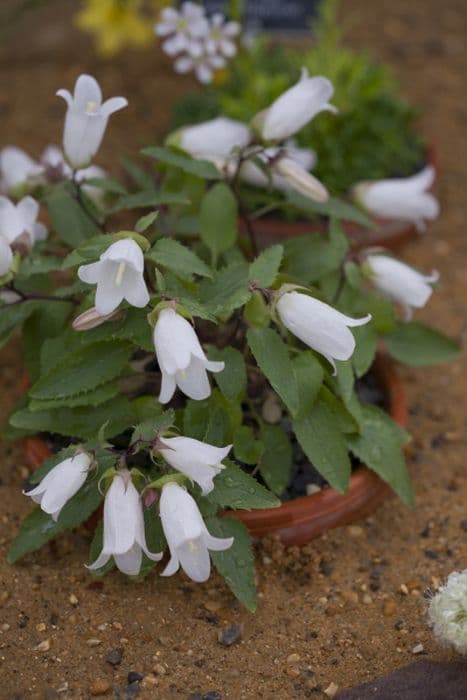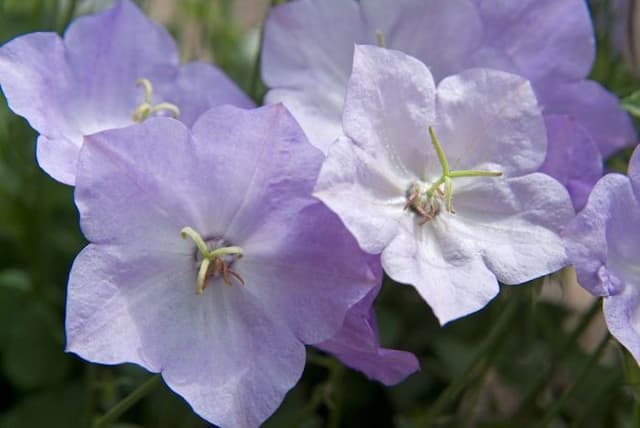Cardinal Flower Lobelia × speciosa 'Monet Moment'

ABOUT
The Lobelia × speciosa 'Monet Moment', commonly known as Lobelia, is a striking plant known for its unique and vibrant flowers. The blossoms are a mix of soft pink and cream with a gradual blending that might remind one of a Monet painting, hence the name 'Monet Moment'. These flowers are tubular in shape, with two lips; the upper lip is usually a set of two small lobes, while the lower lip consists of three larger lobes. They are neatly arranged in dense, terminal spikes that create a vivid display. The foliage of this Lobelia cultivar is attractive as well, with lance-shaped leaves that are sometimes serrated on the edges. The leaves have a lush green hue that provides a lovely contrast to the soft pink shades of the blooms. The stems are sturdy and upright, branching out to give the plant a full and bushy appearance. Overall, the plant exudes a cottage garden charm and brings a burst of delicate color to any garden setting it adorns.
About this plant
 Names
NamesFamily
Campanulaceae
Synonyms
Hybrid Cardinal Flower, Hybrid Lobelia
Common names
Lobelia × speciosa 'Monet Moment'
 Toxicity
ToxicityTo humans
Lobelia can be toxic to humans if ingested, containing alkaloids such as lobeline. Symptoms of poisoning from eating parts of this hybrid Lobelia can include nausea, vomiting, diarrhea, cough, dizziness, tremors, and potentially more severe reactions with large amounts. Ingestion in significant quantities can result in serious health consequences, including respiratory failure and convulsions. Therefore, it's crucial to avoid consuming any part of the plant.
To pets
Lobelia can also be toxic to pets, potentially resulting in similar symptoms of poisoning as seen in humans. If your pet ingests parts of this plant, it may experience vomiting, diarrhea, excessive drooling, lethargy, or abnormal heart rate. In severe cases, ingestion can lead to more critical conditions such as seizures or even coma. Pet owners should prevent their animals from eating any part of this Lobelia hybrid to avoid these risks.
 Characteristics
CharacteristicsLife cycle
Perennials
Foliage type
Deciduous
Color of leaves
Green
Flower color
Pink
Height
2 feet (60 cm)
Spread
1 feet (30 cm)
Plant type
Herb
Hardiness zones
6
Native area
North America
Benefits
 General Benefits
General Benefits- Attracts Wildlife: The Lobelia × speciosa 'Monet Moment', commonly known as Cardinal Flower, is a favorite of hummingbirds and butterflies, attracting these pollinators to the garden.
- Aesthetic Appeal: With its striking deep red flowers, this plant adds vibrant color and visual interest to any garden or landscape.
- Ease of Care: As a hardy perennial, the Cardinal Flower is relatively easy to care for, requiring minimal maintenance once established.
- Borders and Edging: It can provide structure and borders in garden design, serving as an excellent edging plant with its upright growth habit.
- Long Blooming Period: The plant has a long flowering season, which can last from mid-summer to early fall, offering extended beauty in the garden.
- Versatility: Suitable for a variety of garden settings, including mixed borders, water gardens, and cottage gardens.
- Soil Adaptability: It is adaptable to a range of soil conditions, though it prefers moist, well-drained soils.
- Resistant to Deer: The Cardinal Flower is not a favored plant by deer, making it a good choice for areas where deer browsing is a problem.
- Color Coordination: Its vivid red blooms can be used to create striking color combinations with other plants or to provide a contrast against green foliage.
- Native Plant Advantages: As a plant native to parts of North America, it can support local ecosystems and is generally easier to grow within its natural range.
 Medical Properties
Medical PropertiesThis plant is not used for medical purposes.
 Air-purifying Qualities
Air-purifying QualitiesThis plant is not specifically known for air purifying qualities.
 Other Uses
Other Uses- The Lobelia × speciosa 'Monet Moment' can be used as a natural pest deterrent, as its strong scent is said to repel certain insects.
- This plant's brightly colored flowers make for an excellent natural dye for fabrics or paper, giving a hint of blue-violet tint.
- With its striking spikes of purple-red flowers, the Lobelia can serve as a source of inspiration for artists and photographers.
- Lobelia can be used in educational settings, such as schools and nature programs, to teach about pollination and plant biology.
- The elegant form and vivid coloration of the Lobelia can be featured in botanical gardens and conservatories for aesthetic enhancement.
- The plant can be integrated into ponds or water features in gardens due to its ability to thrive in moist conditions.
- For ceremonial or symbolic use, the Lobelia's flowers can be included in floral arrangements to symbolize dignity and solitude.
- Lobelia can be utilized within ecotherapy practices, which use direct contact with nature as a therapeutic tool for mental well-being.
- Its structural form and color can act as a natural marker or point of reference in landscape design and orientation.
- Components of the plant, such as its stalks, can be studied for potential use as raw materials in biodegradable plastics or other sustainable materials.
Interesting Facts
 Feng Shui
Feng ShuiThe Lobelia is not used in Feng Shui practice.
 Zodiac Sign Compitability
Zodiac Sign CompitabilityThe Lobelia is not used in astrology practice.
 Plant Symbolism
Plant Symbolism- Devotion and Loyalty: The Lobelia, often associated with devotion due to its perennial nature, represents lasting love and unwavering loyalty in relationships.
- Attraction: With its striking colors, Lobelia can symbolize an unspoken attraction or the magnetism one person feels towards another.
- Distinction: The unique and intricate structure of the flowers may symbolize someone's desire to stand out or to celebrate what makes someone or something special.
 Water
WaterCardinal Flower hybrids like Lobelia × speciosa 'Monet Moment' should be kept consistently moist, so watering thoroughly when the top inch of the soil starts to feel dry is essential. This may mean watering every couple of days during hot or dry periods, and less frequently during cooler, wetter conditions. It's important to avoid letting the soil dry out completely, as this can stress the plant. To ensure deep hydration, apply approximately 1 gallon of water to the plant's base every week during the growing season, adjusting as necessary for rainfall and temperature variations.
 Light
LightCardinal Flower hybrids prefer a spot where they receive full sun to partial shade. However, in areas with particularly hot summers, providing some afternoon shade can help protect the plant from excessive heat. These Lobelia hybrids will thrive with morning sunlight and dappled afternoon sun, which provides a balance of light for photosynthesis and protection from the intense late-day sun.
 Temperature
TemperatureCardinal Flower hybrids are typically hardy and can endure a temperature range from about 60 to 90 degrees Fahrenheit. They may survive brief periods outside this range, but prolonged exposure to temperatures below 60 or above 90 degrees may stress the plant. The ideal growing conditions for Lobelia × speciosa 'Monet Moment' would be consistently warm days with temperatures staying within the 70 to 85 degrees Fahrenheit range.
 Pruning
PruningPruning Cardinal Flower hybrids such as Lobelia × speciosa 'Monet Moment' is done to maintain their shape, encourage bushier growth, and promote more blooms. Deadheading spent flowers will help stimulate new bloom production. It's best to prune these plants in late winter or early spring before new growth begins. Cut back any dead or damaged stems to maintain plant health and appearance.
 Cleaning
CleaningAs needed
 Soil
SoilCardinal Flower 'Monet Moment' thrives best in a well-draining, fertile soil mix with a pH range of 6.0-7.0. A combination of loam, peat, and sand or perlite can provide the necessary drainage and nutrients.
 Repotting
RepottingCardinal Flower 'Monet Moment' should be repotted every 1-2 years to refresh the soil and accommodate root growth.
 Humidity & Misting
Humidity & MistingCardinal Flower 'Monet Moment' prefers moderate to high humidity levels but can adapt to average room humidity if the soil moisture is maintained.
 Suitable locations
Suitable locationsIndoor
Keep 'Monet Moment' in bright indirect light and moist soil.
Outdoor
Plant 'Monet Moment' in part shade, moist but well-draining soil.
Hardiness zone
6-9 USDA
 Life cycle
Life cycleThe Lobelia × speciosa 'Monet Moment', commonly known as hybrid lobelia or Monet Moment Lobelia, begins its life as a seed, typically sprouting in warm, moist soil conditions in late winter or early spring. After germination, it enters the seedling stage, developing a basic root system and its first true leaves. As it matures into the vegetative stage, the plant grows rapidly, producing a rosette of mid-green leaves and branching stems that set the foundation for future flowering. During the flowering stage, which occurs in summer and often extends into autumn, spikes of vibrant flowers in shades of red, pink, or purple attract pollinators and add visual interest to gardens. After pollination, the plant produces seed pods that, once matured, release seeds for the next generation. As temperatures cool and daylight shortens, the hybrid lobelia enters dormancy or may die back completely, depending on the climate, concluding its annual or perennial cycle.
 Propogation
PropogationPropogation time
Late spring to early summer
The Lobelia × speciosa 'Monet Moment', commonly known as the hybrid lobelia, can be propagated by division, which is the most popular method for this perennial plant. This is best done in the spring, as the new growth begins to emerge. To propagate by division, you should carefully lift the plant from the ground using a garden fork, ensuring not to damage the root ball. Gently tease apart the clumps into smaller sections, ensuring each division has a good portion of roots and several shoots. Replant the divisions immediately into well-prepared soil at the same depth they were previously growing. Water the new plants thoroughly to help establish them. This method allows gardeners to quickly increase their stock of plants while maintaining the characteristics of the parent plant.









